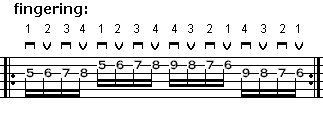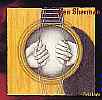Hi everybody! This is the first in a series of lessons intended to help you break out of ruts, think and play more creatively, and offer some insights into how and why I do what I do. On with our first lesson.
The guitar tends to fall into repeating, movable fingerings: scale patterns, movable chord shapes, arpeggios, whatever. But what usually happens: you end up playing the same things all the time because they are the things you know best, because they are the easiest, pattern oriented things. The patterns are controlling you, when you should be controlling the patterns. This is an attitude thing: acknowledge what you know best, accept and be grateful for patterns that fall easily and naturally under your fingers, but don't be dominated by them! Change your mindset by getting in the habit of consciously going against the form as often as you go with the form. What do I mean? Here's an example (you can do this with almost anything you know, but try this, it has some other additional benefits).
Four fingers, four frets in a row. It's the basic unit of half-step movement for any string player. Here's an exercise that goes with the form:

Everything about this one is with the form:
Try accenting (an extra hard, loud stroke) on the first of each group of four- takes a little more thought, but still fits fairly naturally with the form of the exercise.
OK, now let's go against the form:


Now you've a three-notes-per-beat idea going up against your four finger grouping and down-up picking pattern that we just got comfy with.
Try accenting the first of each three -- a lot trickier. If you are picking with consistent down-up alternation, you will be accenting a down, then an up. Nothing about this follows the natural flow of fingers laying on frets. Aggravated? Good, you're awake now. You may have taken your first step towards more conscious guitar playing- that is, the practice of having the idea first, then working out how to play it, instead of letting the patterns of the guitar generate cliches that substitute for ideas. Have fun, work with the exercises, make up your own variations. Look for opportunities to apply these concepts in music that you are playing or learning. We'll go deeper into them next time.
Ben Sherman is a guitarist from Maryland who has over 27 years playing experience. He has also been giving private lessons for many years, helping guitarists of all levels discover the joy of music-making.
His debut CD is entitled "First Light", which features eight electric rock/fusion numbers and two acoustic pieces.
